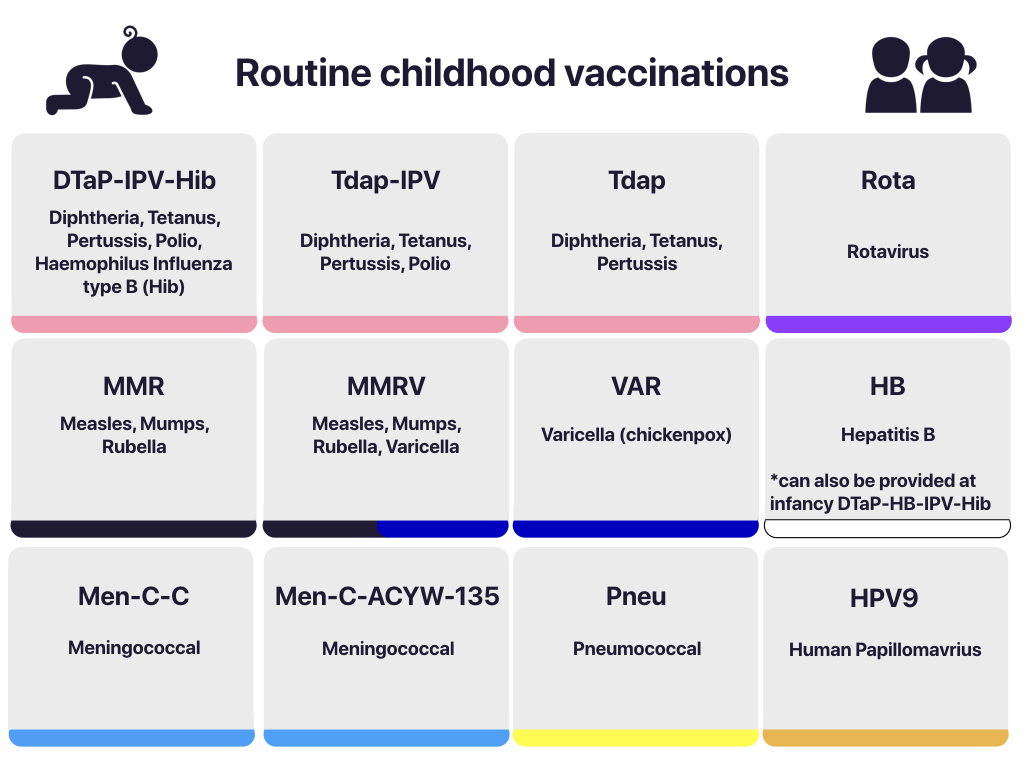Ages and Vaccines
Infants and Toddlers
A child’s immune system is not fully developed at birth. In the first year of life, an infant’s immune system develops. This makes an infant more vulnerable to communicable diseases. This is also why infants need many doses of vaccines in the first year of life, to prime the immune system and develop immunity. Vaccines protect infants and children when they are most vulnerable and work best when children are immunized on time. These strategies have significantly reduced infant mortality rates in Canada and across the world.Table 2.1 is an example of a routine government-funded vaccine schedule in early childhood.
Table 2.1: Routine Vaccines During Early Childhood in Ontario
| Age | Vaccine | Vaccine-Preventable Illness |
|
2 months
|
DTaP-IPV-Hib
|
Diphtheria, Tetanus, Pertussis, Polio, Haemophilus Influenzae type B (Hib) |
|
Pneu-C-13
|
Pneumococcal
|
|
|
Rota
|
Rotavirus
|
|
|
4 months
|
DTaP-IPV-Hib
|
Diphtheria, Tetanus, Pertussis, Polio, Haemophilus Influenzae type B (Hib)
|
|
Pneu-C-13
|
Pneumococcal
|
|
|
Rota
|
Rotavirus
|
|
|
6 months
|
DTaP-IPV-Hib
|
Diphtheria, Tetanus, Pertussis, Polio, Haemophilus Influenzae type B (Hib)
|
|
Rota
|
Rotavirus
|
|
|
12 months
|
Men-C-C
|
Meningococcal Disease
|
|
MMR
|
Measles, Mumps, Rubella | |
|
Pneu-C-13
|
Pneumococcal
|
|
|
15 months
|
Var
|
Varicella (chickenpox)
|
|
18 months
|
DTaP-IPV-Hib
|
Diphtheria, Tetanus, Pertussis, Polio, Haemophilus Influenzae type B (Hib)
|
|
4-6 years
|
MMRV Tdap-IPV
|
Measles, Mumps, Rubella, Varicella (chickenpox), Diphtheria, Tetanus, Pertussis, Polio
|
There is variation in how each province and territory approaches vaccine exemptions. In Ontario, for example, under the Ontario Child Care and Early Years Act (2014), children who attend child care centres are required to either be immunized against the diseases listed in Table 2.1 or have a valid exemption. A medical exemption form is completed by a legally qualified medical provider (i.e. physician or nurse practitioner). A parent who has a philosophical or religious objection may complete a different exemption form. In Ontario, exemptions are granted on the grounds that immunizations conflict with the sincerely held convictions of the parents’ religion or conscience or that a legally qualified medical provider gives medical reasons to the child care centre as to why the child should not be immunized (Ontario Child Care and Early Years Act, Reg. 137/15s).
School Age Children
By school entry, students should be up to date with most routine childhood vaccinations. Contagious diseases can spread quickly in a school setting, so it is important to ensure that school aged children are up to date with their immunizations. Table 2.2 is an example of a government-funded vaccine schedule for school-age children.
Table 2.2: Vaccine Schedule for School Age Children in Ontario
| Age | Vaccine | Vaccine-Preventable Illness |
|
4-6 years
|
MMRV
|
Measles, Mumps, Rubella, Varicella (chickenpox)
|
|
Tdap-IPV
|
Diphtheria, Tetanus, Pertussis, Polio
|
|
|
Grade 7
|
HB
|
Hepatitis B (2 or 3 doses)
|
|
HPV9
|
Human Papillomavirus (2 doses)
|
|
|
Men-C-ACYW-135
|
Meningococcal Disease
|
|
|
14-16 years
|
Tdap
|
Tetanus, Diphtheria, Pertussis
|
In Ontario, under the Immunization of School Pupils Act (1990), students who attend school are required to provide proof of immunization against the following diseases: diphtheria, tetanus, polio, measles, mumps, rubella, meningococcal disease, pertussis, varicella (children born 2010 or later) or have a valid exemption. Parents need to provide a record of their child’s immunization status to the local Public Health Unit. A medical exemption form is completed by a legally qualified medical provider. A parent who has a philosophical or religious objection must attend a mandatory education session and complete the standardized Ministry approved exemption form.

Healthy Adults
Vaccinations are not just for children. Vaccines are safe and protect you and those around you from vaccine-preventable diseases. As we get older, the protection we had from previous vaccinations can decrease for some diseases. Getting another dose, known as a booster, can increase our immunity to provide the best protection. Some adults may have missed one or more of their vaccines when they were a child. They may need to catch up and get these vaccines now. There are also diseases that are more common in adults—even healthy adults—such as shingles. This is why additional vaccines are needed as we get older.
Many Canadian adults are not up to date with their vaccines. Healthcare providers can assess what is needed to be fully protected. The following table is an example based on the Ontario provincial immunization schedule. Table 2.3 is an example of recommended vaccines for health adults.
Table 2.3: Ontario Vaccine Schedule for Healthy Adults
| Vaccine | Vaccine-Preventable Illness | Considerations |
|
Td or Tdap
|
Tetanus, Diphtheria (pertussis)
|
|
|
HZ
|
Herpes Zoster (shingles)
|
|
|
Inf
|
Influenza
|
Annually
|
|
Pneu-P-23
|
Pneumococcal
|
65 years
|
|
HA
|
Hepatitis A
|
Not publicly funded for healthy adults (2 doses)
|
|
HB
|
Hepatitis B
|
Not publicly funded for healthy adults (3 doses)
|
|
HPV9
|
Human Papillomavirus (HPV)
|
Not publicly funded for healthy adults (3 doses)
|

